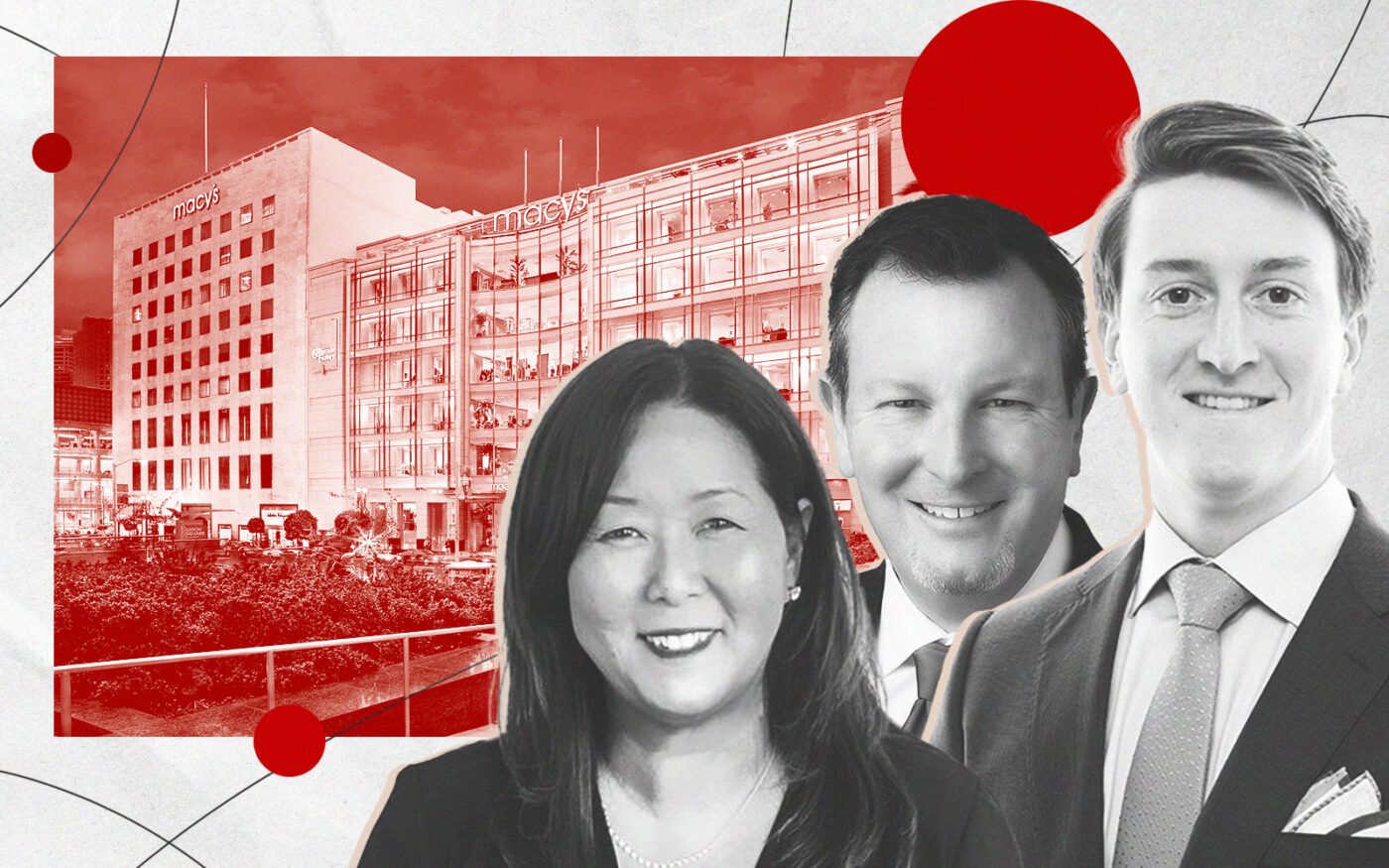 Macy’s to shutter longtime store in San Francisco’s Union Square
Macy’s to shutter longtime store in San Francisco’s Union Square
Trending
Planning the future at Union Square — with or without Macy’s
Possible store closure allows agents and advocates to “dream a little”

Some of Union Square’s top commercial agents mourned the potential loss of Union Square’s iconic Macy’s this week while playing a guessing game of what could happen next.
Guesses include the option that Macy’s could stay in its iconic building on the square, as the company has not announced specific location closures.
“Nothing shocks me at this point, people do things for all kinds of reasons, but this is their West Coast flagship store,” Kazuko Morgan, a Cushman & Wakefield retail agent, told TRD.
“You think of Union Square and you think of Macy’s,” she said.
Given that Macy’s owns the property, a possible closure in Union Square is different from other locations where the retailer merely leases, Morgan said.
“They have much more control over what they can and cannot do,” she noted.
There is hope the store might not close at all.
According to a Macy’s spokesperson, a “final decision on specific locations has yet to be made.” The company intends to close 150 Macy’s stores over the next few years and invest more in the 350 others it is keeping “to create a more modern Macy’s Inc. and enhance the customer experience,” the retailer confirmed.
“I believe that we should work toward a solution that allows Macy’s to keep this iconic store open,” said Marisa Rodriguez, CEO of the Union Square Alliance, in a statement. “However, if that does not come to pass, our expectation is that a new owner for this iconic site will come forward to continue a fresh and vibrant vision at this critical location.”
Pricing an icon
A source close to the department store giant said it was currently evaluating the potential real estate value and the future sales profitability growth potential at the 700,000-square-foot flagship department store that it has owned since the mid-1940s.
Commercial agents who spoke with TRD did not want to hazard a guess at what the property could be worth, but Cameron Baird, a retail agent with Avison Young, said the building represents “irreplaceable real estate.” Bargain hunters looking to take advantage of San Francisco’s downturn are likely to be disappointed, he added.
“You can’t buy buildings on Union Square or on Fifth Avenue or on Rodeo Drive regularly at any sort of a discount. It just doesn’t happen,” he said.
The city most recently assessed 170 O’Farrell Street at $187 million in land value for its nearly 2 acres in the heart of Union Square and $167 million in structural value. The eight-story building has a historic facade from 1928 facing O’Farrell Street, while the glass-covered side facing Union Square is the result of a late 1990s renovation.
If Macy’s did eventually close its West Coast flagship, it would not happen before 2025.
The timeline “gives people time to digest and really understand the impact” as well as think about the future, Morgan said.
“How can this unfortunate situation turn into something where we have the opportunity to get additional uses and tenants and generate more traffic and visitors to San Francisco and Union Square?” she asked.
Updating Union Square
“It would be a real loss if they ultimately decided to leave, but I’m hopeful that they’re able to figure out some way where they can achieve all their financial goals and still be a presence in Union Square,” said Baird.
Given that Macy’s also owns Blue Mercury and Bloomingdale’s, and has said it wants to invest more in the latter two brands, Baird said he could imagine a scenario where all three have a presence under one Union Square roof. Another possibility is that Macy’s could sell the building but stay on as a leaseholder on the lower floors, while a food hall or marketplace-style maker space goes in on the upper floors, he said.
“The city, the neighbors and merchants associations and the brokers can all figure out a way where this evolution takes place,” Baird said. “Macy’s can affect the sale of the building and still remain in the square in some shape or form.”
Macy’s has anchored Union Square for 75 years, said Rodriguez of the Union Square Alliance, and as the market evolves post-COVID that anchor is still needed, but it doesn’t need to look exactly the same as it does now.
“Let’s allow ourselves to dream a little about what this could look like,” she said. “Macy’s can be reimagined in this space and just think of all of the possibilities.”
It would be great if Macy’s decided to stay, but either way, the neighborhood is in “a period of transformation and remains ripe for opportunity,” said Alex Sagues of CBRE, who was “disappointed but not surprised” to hear about the potential closure.
“Retail is changing rapidly and footprints that worked 30 years ago might not work today,” he said.
Macy’s previous sales
Prognosticators can look at the previous two buildings that Macy’s has sold in the square recently as a hint to what its mixed-use future might look like. The former I. Magnin store next door to its flagship location sold for $250 million to developer Sand Hill Properties in 2019 and in 2016 it sold its former Men’s Store across Stockton to Blatteis & Schnur and Morgan Stanley Real Estate for the same price.
Yves St. Laurent signed a deal to lease the three lowest floors of the I.Magnin building in early 2022 and offices are planned for the middle floors, while the top floors will be residential. The Men’s Store has reborn as 100 Stockton, a retail, dining and office project with 65,000 square feet of flex event space from Convene on its fourth and fifth floors and upscale Japanese Peruvian restaurant Chotto Matte on its roof.
Morgan represents 100 Stockton and said that while she would have liked to have it fully leased at this point, all deals are taking longer in the current environment. The ownership is dividing up the bigger chunks of space to attract smaller tenants as “flagship tenants are more dormant at the moment.”
In the meantime, she said, Chotto Matte and Convene have both reported that demand has “exceeded expectations.”
“If you give people reasons to go somewhere and provide a great environment and service, they’re going to come back and continue to come back,” she said.
Sagues agreed that “well-curated store experiences have performed well” and added that a few deals have recently been signed in the square, with more in progress. He couldn’t cite examples due to NDAs, but said there has been “extremely strong” demand in the square, despite “higher vacancy for larger format spaces with some notable vacancies.”
He also pointed to the international companies investing in or near the square — Chanel’s purchase of 340 Post for $63 million, South Korean Hanwha’s purchase of 300 Grant for $155 million and Ikea’s purchase of 945 Market Street for $198 million as examples of “the global nature of the city.”
He added that as long as San Francisco continues to be the number one spot in the world for VC investment and innovation, those factors will promote sales and growth in the city — even without a Macy’s.
“San Francisco is one of the most iconic and important cities in the world,” he said. “San Francisco’s recovery will continue.”
Read more
 Macy’s to shutter longtime store in San Francisco’s Union Square
Macy’s to shutter longtime store in San Francisco’s Union Square
 Convene to open flex event venue at 100 Stockton
Convene to open flex event venue at 100 Stockton
 300 Grant Avenue sells for $155M to South Korea’s Hanwha
300 Grant Avenue sells for $155M to South Korea’s Hanwha
 Yves Saint Laurent leases space in I Magnin building in SF’s Union Square
Yves Saint Laurent leases space in I Magnin building in SF’s Union Square




